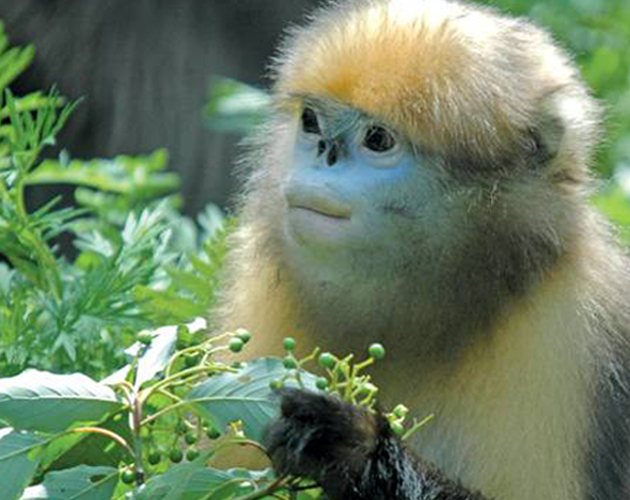A Golden Opportunity
Working alongside Chinese researchers, two San Diego State professors have a chance to save the golden monkey from extinction.

In the dense forests of southern China's Guizhou province lives an elusive creature with a dubious claim to fame.
Known for its dark golden fur, distinctive flat nose and timid disposition, Rhinopithecus brelichi, the Guizhou snub-nosed monkey, is among the most endangered species on the planet. Humans are its prime enemy and, paradoxically, its only hope for survival.
San Diego State University geography professor Li An is among those working to ensure the continued existence of the intriguing creature affectionately known as China's golden monkey.
"Once these species are lost, they are gone forever," An said. "It would be a tragedy if future generations were never able to see [the monkeys] or do research about them."
A Chinese native, An has long been intrigued with his country's endangered species.
Guard for the golden monkey
His doctoral research examined the impacts of human activity on giant panda conservation. An linked the effects of human socioeconomic and lifestyle dynamics to changes in the pandas' habitat, and developed a model of action to protect their environment.
Now, he has similar plans to guard the golden monkey's habitat against human encroachment. With support from SDSU's University Grant Program and the Chinese Academy of Sciences, An began a pilot study. He installed five infrared cameras deep in the interior of the Fanjingshan National Nature Reserve, where the 800 or so remaining Guizhou monkeys reside.
By monitoring the primates' activities, An hopes to learn more about their movement patterns, social interactions and sources of food. This information will allow him to create a map of the community's habitat, outlining where and how the monkeys use the land. Eventually, An will develop guidelines to help humans coexist with the golden monkeys.
Already, An's cameras have successfully photographed the primates. During a recent trip to Guizhou, An himself was fortunate to have witnessed a community of about 100 golden monkeys traveling through the reserve, vocalizing and breaking twigs as they foraged.
Victims of modernization
Of all the species listed by the Convention on International Trade in Endangered Species as "critically endangered," 25 percent are found in China. And that list has grown as China's booming population inches ever closer to the most remote corners of the country.
Hundreds of years ago, the monkeys roamed freely throughout southern China's lush subtropical forests. But China's march toward development turned forests into farmland and factories.
Even the Fanjingshan reserve is not sacrosanct. At its edges, rural residents cut trees to use for firewood or timber, further reducing the primates' habitat.
Also treacherous are the poachers, who stalk and kill the golden monkeys for their meat and pelts, the latter of which are thought to ward off rheumatism. The most devastating human activity in recent years is the illegal mining that has damaged vast areas inside the reserve.
Intelligent creatures
As a result of so much pressure on their populations, the four known species of snub-nosed monkeys, three in China and one in Vietnam, are threatened. In fact, the Guizhou snub-nosed monkey is as endangered as the giant panda. Most of what primatologists know about these animals has been gleaned from research on the least threatened species, the Sichuan snub-nosed monkey.
Chia Tan, Asia program head for the San Diego Zoo's Division of Conservation and Research for Endangered Species (CRES), has studied the Sichuan snub-nosed monkeys, and is collaborating with Li An and his SDSU colleague, anthropology professor Erin Riley, in their Guizhou monkey research.
Scattered throughout four Chinese provinces, the Sichuan species is the true jin si hou (golden monkey in Mandarin). These monkeys live in large groups, occasionally numbering from 400 to 600, a hallmark of all Chinese snub-nosed monkeys but extremely unusual among primates. Each of these groups contains dozens of units, most comprising one male and three to four female monkeys plus their offspring.
As the various units move through the forests, Tan explained, individual monkeys coordinate their movement by communicating with each other through distinctive vocalization patterns. Simple contact calls resemble a human baby's whine, while a "hoo-chuck" alarm call warns of approaching danger.
Tan said snub-nosed monkeys have developed the same kinds of complex behaviors that enable humans to live peaceably in large social groups.
For example, although the monkeys prefer a defined breeding seasonfrom September through Novemberthey mate throughout the year. Mating outside the breeding season appears to be a socially motivated behavior tied to reconciliation after conflict, Tan said.
Reclaiming lost habitats
Tan's research on the Sichuan snub-nosed monkey is providing a solid basis for An and Riley as they attempt to learn more aboutand protectits cousin in Guizhou. CRES can boast a proven record of success in advancing scientific knowledge of Asian primates, preserving existing habitats, reclaiming lost habitats and discouraging human hunting to help preserve endangered species.
Early next year, SDSU geography and anthropology students will join the Guizhou snub-nosed monkey project, working at the Fanjingshan National Nature Reserve alongside students from the Chinese Academy
of Sciences, a partner in the research. With An's cameras monitoring the monkeys' behavior, student researchers in the field will collect valuable additional data about the ecology of their habitat, including food sources.
Both Tan and An believe their work will help ensure the survival and resurgence of the Guizhou golden monkey.
"As we more clearly understand the behavior of the Guizhou snub-nosed monkeys and the effects of human interaction on their habitat, we will be able to make more specific recommendations to improve their chances of survival," An said.



